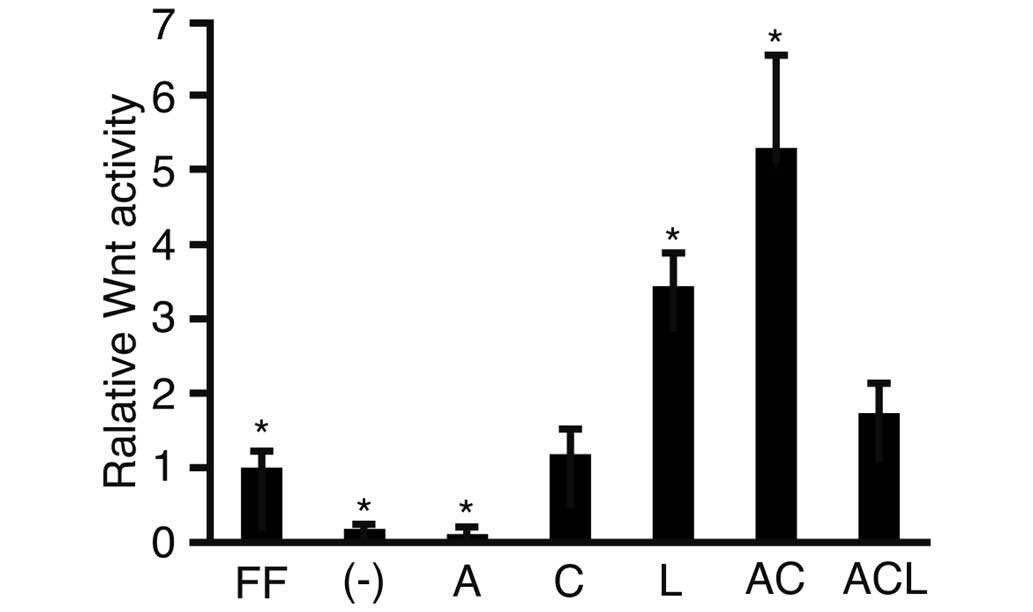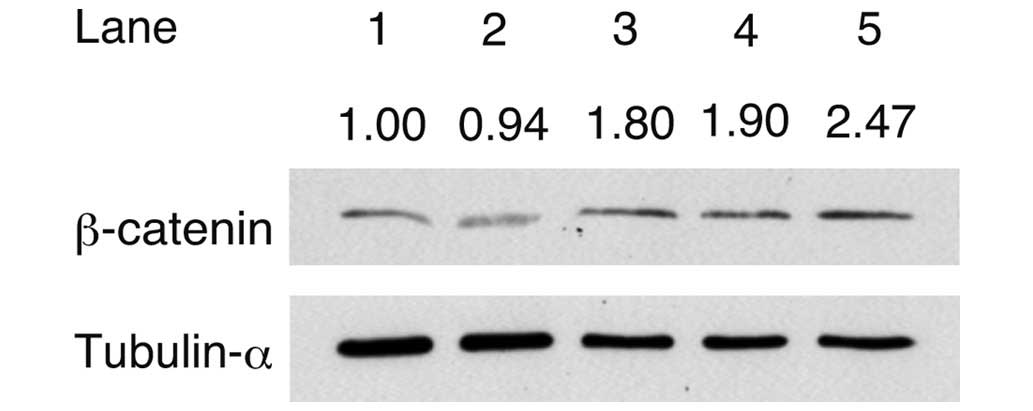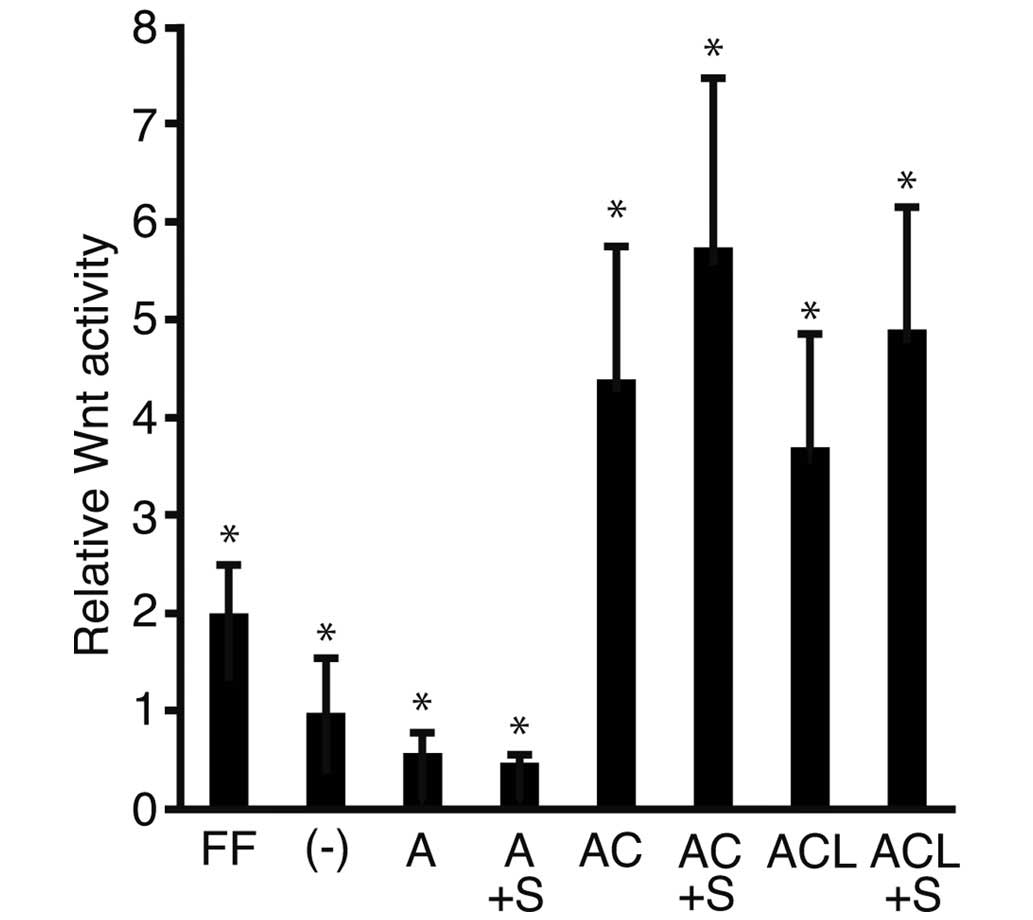|
1
|
Meng G, Liu S and Rancourt DE: Synergistic
effect of medium, matrix and exogenous factors on the adhesion and
growth of human pluripotent stem cells under defined, xeno-free
conditions. Stem Cells Dev. 21:2036–2048. 2012. View Article : Google Scholar
|
|
2
|
Dalton S: Signaling networks in human
pluripotent stem cells. Curr Opin Cell Biol. 25:241–246. 2013.
View Article : Google Scholar :
|
|
3
|
Dowell KG, Simons AK, Bai H, Kell B, Wang
ZZ, Yun K and Hibbs MA: Novel insights into embryonic stem cell
self-renewal revealed through comparative human and mouse systems
biology networks. Stem Cells. 32:1161–1172. 2014. View Article : Google Scholar
|
|
4
|
Tomizawa M, Shinozaki F, Sugiyama T,
Yamamoto S, Sueishi M and Yoshida T: Activin A maintains
pluripotency markers and proliferative potential of human induced
pluripotent stem cells. Exp Ther Med. 2:405–408. 2011.PubMed/NCBI
|
|
5
|
Shin M, Alev C, Wu Y, Nagai H and Sheng G:
Activin/TGF-beta signaling regulates Nanog expression in the
epiblast during gastrulation. Mech Dev. 128:268–278. 2011.
View Article : Google Scholar : PubMed/NCBI
|
|
6
|
Miyanari Y and Torres-Padilla ME: Control
of ground-state pluripotency by allelic regulation of Nanog.
Nature. 483:470–473. 2012. View Article : Google Scholar : PubMed/NCBI
|
|
7
|
Xu RH, Peck RM, Li DS, Feng X, Ludwig T
and Thomson JA: Basic FGF and suppression of BMP signaling sustain
undifferentiated proliferation of human ES cells. Nat Methods.
2:185–190. 2005. View
Article : Google Scholar : PubMed/NCBI
|
|
8
|
Tomizawa M, Shinozaki F, Sugiyama T,
Yamamoto S, Sueishi M and Yoshida T: Activin A is essential for
Feeder-free culture of human induced pluripotent stem cells. J Cell
Biochem. 114:584–588. 2013. View Article : Google Scholar
|
|
9
|
Li W, Zhou H, Abujarour R, Zhu S, Young
Joo J, Lin T, Hao E, Schöler HR, Hayek A and Ding S: Generation of
human-induced pluripotent stem cells in the absence of exogenous
Sox2. Stem Cells. 27:2992–3000. 2009.PubMed/NCBI
|
|
10
|
Li Y, Zhang Q, Yin X, Yang W, Du Y, Hou P,
Ge J, Liu C, Zhang W, Zhang X, et al: Generation of iPSCs from
mouse fibroblasts with a single gene, Oct4 and small molecules.
Cell Res. 21:196–204. 2011. View Article : Google Scholar
|
|
11
|
Ying QL, Wray J, Nichols J, Batlle-Morera
L, Doble B, Woodgett J, Cohen P and Smith A: The ground state of
embryonic stem cell self-renewal. Nature. 453:519–523. 2008.
View Article : Google Scholar : PubMed/NCBI
|
|
12
|
Wu D and Pan W: GSK3: A multifaceted
kinase in Wnt signaling. Trends Biochem Sci. 35:161–168. 2010.
View Article : Google Scholar :
|
|
13
|
Itoh K, Brott BK, Bae GU, Ratcliffe MJ and
Sokol SY: Nuclear localization is required for Dishevelled function
in Wnt/beta-catenin signaling. J Biol. 4:32005. View Article : Google Scholar : PubMed/NCBI
|
|
14
|
Chen W, ten Berge D, Brown J, Ahn S, Hu
LA, Miller WE, Caron MG, Barak LS, Nusse R and Lefkowitz RJ:
Dishevelled 2 recruits beta-arrestin 2 to mediate Wnt5A-stimulated
endocytosis of Frizzled 4. Science. 301:1391–1394. 2003. View Article : Google Scholar : PubMed/NCBI
|
|
15
|
McCubrey JA, Steelman LS, Bertrand FE,
Davis NM, Sokolosky M, Abrams SL, Montalto G, D'Assoro AB, Libra M,
Nicoletti F, et al: GSK-3 as potential target for therapeutic
intervention in cancer. Oncotarget. 5:2881–2911. 2014. View Article : Google Scholar : PubMed/NCBI
|
|
16
|
Holland JD, Klaus A, Garratt AN and
Birchmeier W: Wnt signaling in stem and cancer stem cells. Curr
Opin Cell Biol. 25:254–264. 2013. View Article : Google Scholar : PubMed/NCBI
|
|
17
|
Sineva GS and Pospelov VA: β-Catenin in
pluripotency: Adhering to self-renewal or Wnting to differentiate?
Int Rev Cell Mol Biol. 312:53–78. 2014. View Article : Google Scholar
|
|
18
|
Bar-Nur O, Brumbaugh J, Verheul C,
Apostolou E, Pruteanu-Malinici I, Walsh RM, Ramaswamy S and
Hochedlinger K: Small molecules facilitate rapid and synchronous
iPSC generation. Nat Methods. 11:1170–1176. 2014. View Article : Google Scholar : PubMed/NCBI
|
|
19
|
Witty AD, Mihic A, Tam RY, Fisher SA,
Mikryukov A, Shoichet MS, Li RK, Kattman SJ and Keller G:
Generation of the epicardial lineage from human pluripotent stem
cells. Nat Biotechnol. 32:1026–1035. 2014. View Article : Google Scholar : PubMed/NCBI
|
|
20
|
Lam AQ, Freedman BS and Bonventre JV:
Directed differentiation of pluripotent stem cells to kidney cells.
Semin Nephrol. 34:445–461. 2014. View Article : Google Scholar : PubMed/NCBI
|
|
21
|
Pauklin S and Vallier L: The cell-cycle
state of stem cells determines cell fate propensity. Cell.
155:135–147. 2013. View Article : Google Scholar : PubMed/NCBI
|
|
22
|
Singh AM, Reynolds D, Cliff T, Ohtsuka S,
Mattheyses AL, Sun Y, Menendez L, Kulik M and Dalton S: Signaling
network crosstalk in human pluripotent cells: A Smad2/3-regulated
switch that controls the balance between self-renewal and
differentiation. Cell Stem Cell. 10:312–326. 2012. View Article : Google Scholar : PubMed/NCBI
|
|
23
|
Tomizawa M, Shinozaki F, Motoyoshi Y,
Sugiyama T, Yamamoto S, Sueishi M and Yoshida T: Niclosamide
suppresses Hepatoma cell proliferation via the Wnt pathway. Onco
Targets Ther. 6:1685–1693. 2013. View Article : Google Scholar : PubMed/NCBI
|

















